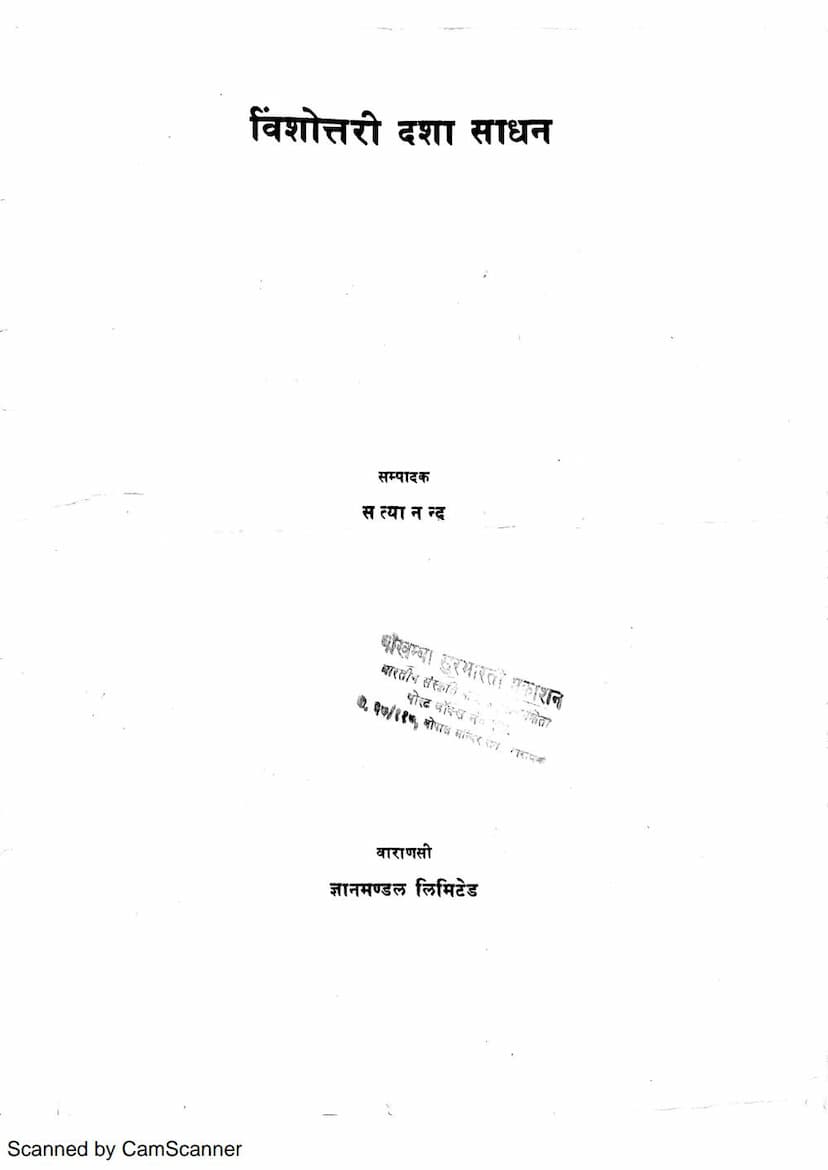Vinshottari Dasha Sadhan
Added to library: September 2, 2025

Summary
Here's a comprehensive summary of the provided Jain text, "Vinshottari Dasha Sadhan" by Satyanand, published by Gyanmandal Limited, based on the scanned pages:
Book Title: Vinshottari Dasha Sadhan Author: Satyanand Publisher: Gyanmandal Limited
Overall Purpose: "Vinshottari Dasha Sadhan" is a guide focused on calculating and understanding the Vinshottari Dasha system, a significant aspect of Vedic astrology. The book aims to provide a method for determining planetary periods (Dashas) based on the birth chart, particularly focusing on the Moon's position. It is designed for both astrologers and the general public interested in understanding astrological calculations.
Core Concepts and Methodology:
-
Nadi-Based Calculations: The book emphasizes that Indian astrology primarily relies on calculations based on constellations (Nadi or Nakshatras). These constellations are considered stable reference points in the sky.
-
The Adya Bindu (Starting Point):
- Historically, Krittika Nakshatra was considered the starting point.
- Currently, Ashwini Nakshatra is the accepted starting point for calculations.
-
Janma Chandra Spashta (Moon's Position at Birth): This is a crucial element. It refers to the angular distance of the Moon from the Adya Bindu at the time of birth. This position is expressed in degrees, minutes, and seconds, or within the framework of Rashis (zodiac signs) and Nakshatras.
-
Vinshottari Dasha System:
- The system assigns specific Mahadashas (major planetary periods) to each of the 27 Nakshatras.
- The sequence of Mahadashas is determined by the Nakshatra in which the person is born.
- The Mahadasha of Ketu starts with Ashwini, followed by Shukra (Venus) in Bharani, Surya (Sun) in Krittika, Chandra (Moon) in Rohini, Bhauma (Mars) in Mrigashira, Rahu in Ardra, Guru (Jupiter) in Punarvasu, Shani (Saturn) in Pushya, and Budha (Mercury) in Ashlesha.
- This cycle of nine planets and their Mahadashas completes across the 27 Nakshatras, with each planet having a specific duration (e.g., Surya 6 years, Shukra 20 years, Rahu 18 years, etc.). The total Dasha period spans 120 years (as per the traditional Vinshottari system).
-
Calculating Dasha at Birth:
- The book explains how to determine which Mahadasha was current at birth based on the Janma Chandra Spashta and the Nakshatra occupied by the Moon.
- It also details how to calculate the remaining portion of the birth Dasha. This is done by subtracting the portion of the Dasha that has already elapsed before birth from the total duration of that Dasha.
-
Importance of Precise Calculations: The text highlights that the Moon's speed is not constant and varies. Therefore, accurate calculations of the Janma Chandra Spashta are vital for precise Dasha calculations. Using detailed calculations based on 12-hour lunar positions (as provided in the Gyanmandal Solar Panchang) is presented as more accurate than simple proportional methods.
-
Practical Application - Tables (Sarani):
- The core of the book consists of several tables designed for practical application.
- Table No. 1 (Sarani No. 1): Provides the cumulative duration of Mahadashas in "madhyam din" (mean days) based on the Rashi and the portion of the Moon's Nakshatra that has elapsed (bhukta ansha).
- Table No. 2 (Sarani No. 2): Offers a more detailed breakdown, providing the cumulative durations (savayav ahargana) based on the minutes and seconds (kala, vikala) of the Moon's position. This is crucial for finer calculations.
- Table No. 3 (Sarani No. 3): Lists the durations of Antardashas (sub-periods within Mahadashas) for each planet.
- Table No. 4 (Sarani No. 4): Provides the durations of Pratyantardashas (sub-sub-periods).
- Tables No. 5 & 6 (Sarani No. 5 & 6): These are crucial for converting Dasha periods into calendar dates. They show the cumulative number of days from the beginning of the year up to any given date, for both normal years and leap years.
-
Example Calculation: The book includes a detailed example demonstrating how to calculate the Mahadasha, Antardasha, and Pratyantardasha for a specific birth date and time. This involves:
- Determining the Moon's precise position at birth.
- Identifying the birth Nakshatra and the ruling Mahadasha.
- Using Tables 1 and 2 to calculate the elapsed portion of the birth Mahadasha.
- Calculating the remaining portion of the Mahadasha.
- Using Table 3 to find the relevant Antardasha and its elapsed portion.
- Using Table 4 for Pratyantardashas.
- Utilizing Tables 5 and 6 to convert the remaining Dasha periods into specific calendar dates and times.
-
Methodological Note on Day Calculation: The book specifies that for Dasha calculations, a month is considered 30 days, and a year is considered 360 days. It explicitly states that a 365-day year is not used for these astronomical calculations.
Key Features:
- Practical Tables: The primary strength of the book lies in its comprehensive tables, which serve as ready reckoners for Dasha calculations.
- Step-by-Step Guidance: The inclusion of an example makes the complex process of Dasha calculation understandable.
- Emphasis on Accuracy: The text stresses the importance of precise lunar positions for accurate astrological predictions.
- Accessibility: While based on astrological principles, it attempts to explain fundamental concepts for a wider audience.
In essence, "Vinshottari Dasha Sadhan" is a practical manual for mastering the Vinshottari Dasha system, providing the tools and explanations necessary to calculate planetary periods and their subdivisions accurately, which are fundamental for astrological analysis in Vedic tradition.